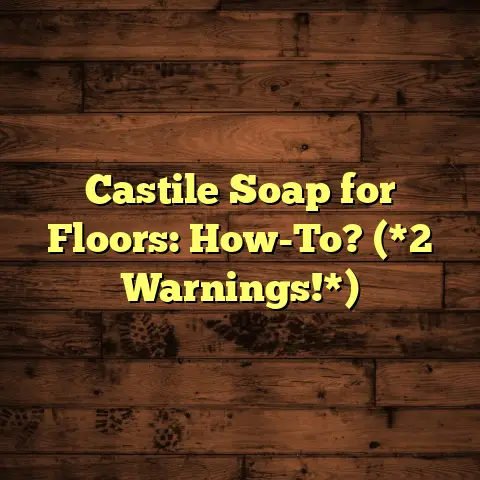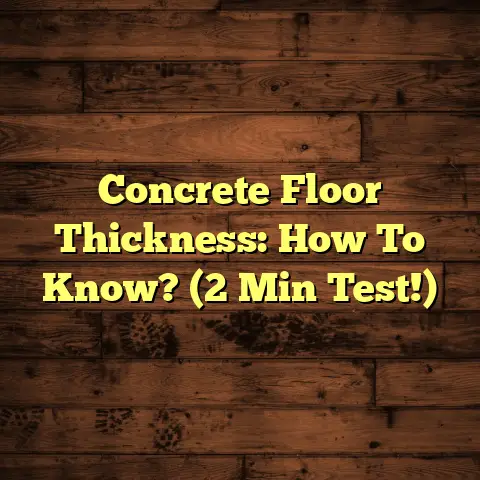Bleach On Tile Floors? (1 Pro Warning!)
We all know bleach, right?
It’s that one cleaning product that seems to have a cult following. Some people treat it like a miracle worker, banishing every stain and germ in sight.
Others? They eye it with suspicion, like it’s the forbidden fruit of cleaning supplies.
It’s a paradox, isn’t it? Such powerful cleaning potential, yet so many potential dangers.
As a flooring contractor for over 15 years, I’ve seen it all when it comes to cleaning mishaps. And bleach on tile floors?
That’s a common one.
So, let’s dive deep into this topic. I’ll share my insights, professional warnings, and some safer alternatives.
Section 1: Understanding Bleach – The Cleaning Powerhouse
1. What is Bleach?
Bleach, in its simplest form, is a chemical solution used for disinfecting, whitening, and stain removal.
The most common type is chlorine bleach (sodium hypochlorite – NaClO), which is a strong oxidizer.
But there’s also oxygen bleach (sodium percarbonate), a gentler alternative.
Chlorine bleach works by breaking down the chemical bonds of stains and killing bacteria and viruses.
Oxygen bleach releases oxygen to lift stains.
2. Why People Use Bleach?
Bleach is popular for a few reasons:
- Effectiveness: It’s a potent disinfectant, killing germs, mold, and mildew.
- Stain Removal: It can tackle tough stains that other cleaners can’t.
- Availability: It’s cheap and readily available in almost every store.
I’ve heard homeowners say things like, “Bleach is the only thing that truly makes my tile floors feel clean!”
Or, “I use bleach on my tile floors every week to keep the mold away.”
It’s easy to see why people are drawn to it.
Section 2: The Appeal of Using Bleach on Tile Floors
1. Types of Tile Floors
Let’s talk tile. There are several types, and bleach interacts differently with each.
-
Ceramic Tile: This is a common, budget-friendly option. It’s generally durable, but the grout is porous.
-
Porcelain Tile: Denser and more durable than ceramic. It’s less porous and more resistant to stains.
-
Vinyl Tile: A synthetic option that’s water-resistant and easy to maintain.
-
Natural Stone Tile: This includes granite, marble, slate. It’s porous and can be damaged by harsh chemicals.
We all love the look of clean, bright tile floors.
It makes a home feel fresh and inviting.
Bleach seems like a quick way to achieve that aesthetic.
2. Stain and Grime Removal
Bleach is effective at removing tough stains and grime from tile floors.
Think about coffee spills, wine stains, mildew in the bathroom, or stubborn dirt tracked in from outside.
I’ve seen bleach successfully remove these stains when other cleaners have failed.
However, here’s the catch:
- Coffee/Wine Stains: Bleach can break down the pigments, but it may also discolor the grout.
- Mildew: Bleach kills mildew, but it doesn’t prevent it from returning if the underlying moisture issue isn’t addressed.
Section 3: The Pro Warning – Risks of Using Bleach on Tile Floors
1. Potential Damage
This is where my “pro warning” comes in.
Bleach can cause significant damage to tile floors, especially the grout.
- Discoloration: Bleach can lighten or yellow grout, creating an uneven, unsightly appearance.
- Grout Degradation: Bleach can weaken the grout over time, making it more prone to cracking and crumbling.
- Tile Damage: While less common, bleach can etch or dull the finish on certain types of tile, particularly natural stone.
I remember one homeowner telling me, “I used bleach on my white tile floors, and now the grout is yellow! It looks terrible.”
Another said, “My grout started crumbling after using bleach for a few months. I had to re-grout the entire floor!”
These are real experiences, and they highlight the risks.
2. Health Risks
Beyond the damage to your floors, bleach poses health risks:
- Respiratory Issues: Bleach fumes can irritate the lungs and trigger asthma attacks. According to the EPA, exposure to high concentrations of chlorine bleach can cause coughing, shortness of breath, and even pulmonary edema. (https://www.epa.gov/)
- Skin Irritation: Direct contact with bleach can cause burns and irritation.
- Eye Damage: Splashes of bleach can cause severe eye damage.
Improper use can lead to hazardous situations.
Mixing bleach with ammonia, for example, creates toxic chloramine gas, which can be fatal.
According to the CDC, about 300 to 400 people are hospitalized each year due to exposure to chlorine gas. (https://www.cdc.gov/)
Section 4: Alternative Cleaning Solutions for Tile Floors
1. Eco-Friendly Options
Luckily, there are plenty of eco-friendly alternatives to bleach.
- Vinegar: A natural disinfectant and deodorizer. Mix equal parts vinegar and water for a gentle cleaner.
- Baking Soda: A mild abrasive that can scrub away stains. Make a paste with water and apply to the stain.
- Hydrogen Peroxide: A gentle bleach alternative that can lighten stains.
These alternatives are safer for your health and the environment.
They’re also less likely to damage your tile floors.
2. Commercial Cleaners
If you prefer commercial cleaners, look for bleach-free options specifically designed for tile floors.
- pH-Neutral Cleaners: These are gentle and won’t damage grout or tile.
- Enzyme Cleaners: These break down organic stains like food and pet messes.
When comparing cleaners, consider:
- Effectiveness: Does it remove stains and grime effectively?
- Cost: Is it affordable?
- Safety: Is it safe for your family and pets?
Section 5: Best Practices for Tile Floor Maintenance
1. Regular Cleaning Routines
Preventing stains and grime buildup is key to avoiding the need for harsh chemicals.
- Daily Maintenance: Sweep or vacuum regularly to remove dirt and debris.
- Weekly Mopping: Mop with a mild cleaner and warm water.
- Safe Tools: Use a microfiber mop to avoid scratching the tile.
A consistent cleaning schedule can make a big difference.
2. Spot Cleaning Techniques
Handle spills and stains promptly to prevent them from setting.
- Blot, Don’t Rub: Rubbing can spread the stain.
- Test First: Test any cleaning product on a small, inconspicuous area first.
- Gentle Cleaners: Start with mild cleaners like dish soap and water.
Remember, prevention is better than cure.
Section 6: Conclusion
So, we’re back where we started, right?
With that bottle of bleach staring at us from the cleaning cabinet.
It’s tempting to reach for it, especially when faced with a stubborn stain.
But remember the “pro warning” I shared.
Bleach can be a powerful ally in cleaning tile floors, but it comes with significant caveats.
Consider the potential damage to your floors, the health risks to your family, and the availability of safer alternatives.
Ultimately, the choice is yours.
But I hope this article has given you the information you need to make an informed decision.
Is that sparkling clean floor worth the risk?
Think about it.





